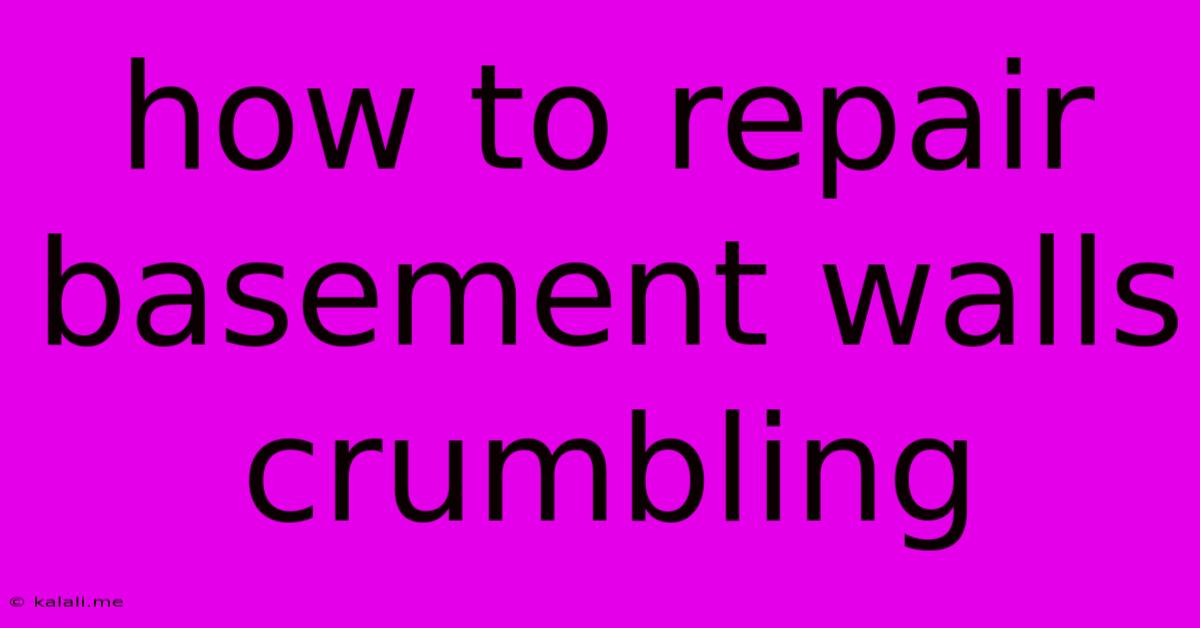How To Repair Basement Walls Crumbling
Kalali
May 31, 2025 · 4 min read

Table of Contents
How to Repair Crumbling Basement Walls: A Comprehensive Guide
Meta Description: Is your basement wall crumbling? This guide provides a step-by-step process for repairing crumbling basement walls, covering causes, prevention, and common repair methods. Learn how to assess the damage, choose the right materials, and complete the job safely and effectively.
Basement walls, often overlooked, can suffer significant damage over time, leading to crumbling and structural instability. This can be caused by several factors, including water damage, poor construction, and soil pressure. Ignoring these issues can lead to more extensive and costly repairs down the line. This comprehensive guide will walk you through identifying the problem, choosing the appropriate repair method, and executing the fix effectively.
Understanding the Causes of Crumbling Basement Walls
Before you begin any repairs, it's crucial to understand why your basement walls are crumbling. Common causes include:
- Water Damage: This is the most prevalent culprit. Water seeps into the walls, weakening the mortar and causing efflorescence (salt deposits), leading to disintegration. Look for signs of dampness, mold, and staining.
- Poor Construction: Inadequate foundation construction, insufficient waterproofing, or the use of substandard materials can lead to premature wall deterioration.
- Soil Pressure: External soil pressure, particularly in areas with expansive clay soils, can exert significant force on basement walls, causing cracks and crumbling.
- Settlement: Uneven settling of the foundation can also contribute to cracking and damage to basement walls.
- Frost Heaving: In colder climates, freezing and thawing cycles can exert pressure on the foundation and walls, leading to cracking and damage.
Assessing the Damage: A Crucial First Step
A thorough assessment is paramount before starting any repairs. This involves:
- Identifying the extent of the damage: Determine how much of the wall is affected. Are we talking about minor cracks, significant sections of crumbling mortar, or bowing walls?
- Locating the source of the problem: Pinpoint the source of water ingress (if any) – leaky pipes, poor drainage, or cracks in the foundation.
- Checking for structural integrity: Ensure the wall isn't bowing or leaning significantly, indicating a more serious structural issue requiring professional help.
Choosing the Right Repair Method
The best repair method depends on the severity of the damage:
Minor Cracks and Crumbling Mortar:
- Mortar Repair: For small cracks and areas of crumbling mortar, carefully remove the loose material, clean the area, and apply new mortar, matching the existing mix as closely as possible. Use a masonry chisel and brush for a clean surface.
Significant Crumbling or Bowing Walls:
- Wall Reinforcement: This may involve installing steel supports or carbon fiber reinforced polymers (CFRP) to stabilize the wall. This is a more complex repair that might require professional assistance.
- Waterproofing: Addressing the source of water damage is essential, which might involve exterior waterproofing, internal drainage systems, or crack injection.
- Foundation Repair: For severe bowing or structural issues, professional foundation repair may be necessary. This could include underpinning, helical piers, or other specialized techniques.
Materials and Tools You Will Need
The specific materials will depend on the chosen repair method, but generally you’ll need:
- Masonry Chisel and Hammer: To remove loose mortar and debris.
- Wire Brush: To clean the wall surface.
- Mortar Mix: Choose a suitable type for your basement wall.
- Trowel: To apply the mortar.
- Level: To ensure even application.
- Safety Glasses and Gloves: For personal protection.
- Steel supports or CFRP (if needed)
Prevention is Key: Long-Term Strategies
Preventing future crumbling is just as important as repairing existing damage. Consider these preventive measures:
- Proper Drainage: Ensure proper grading around your foundation to divert water away from the walls.
- Regular Inspections: Inspect your basement walls regularly for signs of damage.
- Waterproofing: Implement effective waterproofing measures, either internally or externally.
- Maintaining Gutters and Downspouts: Keep gutters and downspouts clear to prevent water from accumulating around your foundation.
When to Call a Professional
For significant structural damage, bowing walls, or if you're unsure about any aspect of the repair process, it's always best to consult a qualified structural engineer or foundation repair specialist. They can assess the situation accurately and recommend the appropriate course of action.
By following these steps and understanding the potential causes and appropriate solutions, you can effectively repair crumbling basement walls and protect your home's structural integrity. Remember that safety should always be your top priority.
Latest Posts
Latest Posts
-
Can I Balance Transfer Someone Elses Debt
Jun 01, 2025
-
Do You Sheetrock The Ceiling First
Jun 01, 2025
-
When Should I Change My Spark Plugs
Jun 01, 2025
-
Cat Dipping Paw In Water To Drink
Jun 01, 2025
-
How To Insert Images Side By Side In Latex
Jun 01, 2025
Related Post
Thank you for visiting our website which covers about How To Repair Basement Walls Crumbling . We hope the information provided has been useful to you. Feel free to contact us if you have any questions or need further assistance. See you next time and don't miss to bookmark.